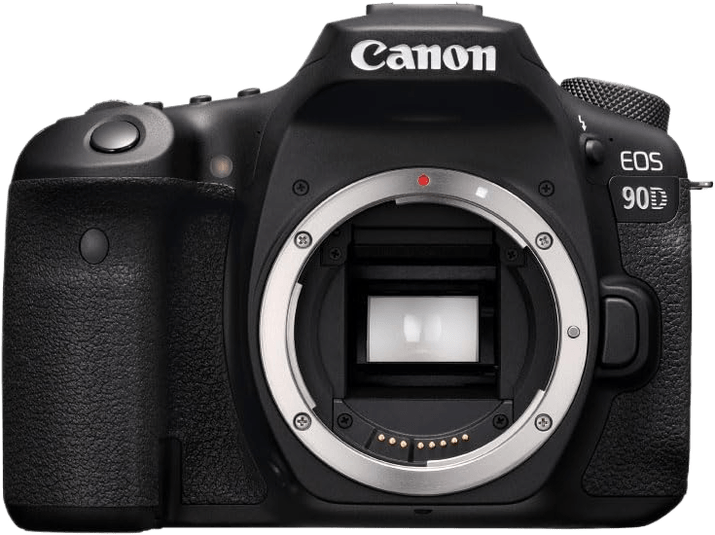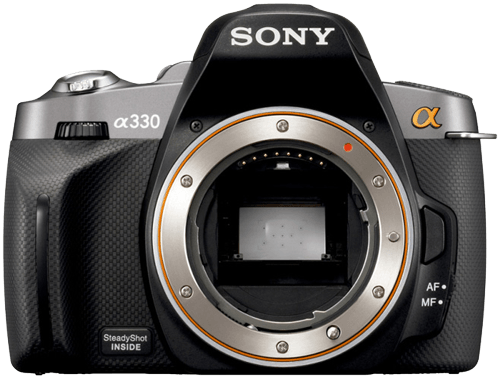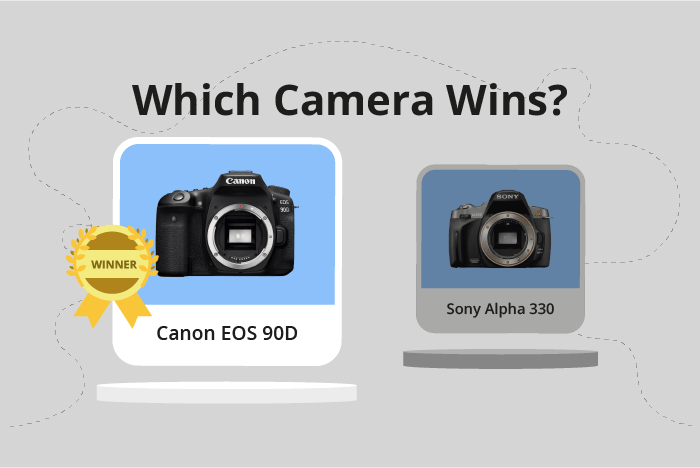Canon EOS 90D vs Sony Alpha 330 Comparison
Canon EOS 90D

Sony Alpha 330

The Canon EOS 90D emerges as the winner with a score of 67/100, while the Sony Alpha 330 trails behind at 42/100. Both cameras are DSLRs and share similar dimensions, with the Canon being slightly larger and heavier (141 x 105 x 77mm, 701g) than the Sony (128 x 97 x 71mm, 529g). The Canon EOS 90D, released in 2019, boasts a higher launch price of $1199, compared to the Sony Alpha 330’s $780 launch price in 2009.
The Canon EOS 90D outperforms the Sony Alpha 330 with its more recent release and higher score. Its superior specifications justify the higher price tag. On the other hand, the Sony Alpha 330 is lighter and more affordable, making it a suitable option for budget-conscious photographers.
Taking all factors into account, the Canon EOS 90D is the better choice for those seeking advanced features and performance. However, the Sony Alpha 330 still holds value for those prioritizing affordability and portability.
Canon EOS 90D vs Sony Alpha 330 Overview and Optics
The Canon EOS 90D outperforms the Sony Alpha 330 in optics, with a score of 62/100 compared to Sony’s 49/100. Both cameras share some specifications, such as APS-C sensor size and lens mounts specific to their brands – Canon EF/EF-S for the 90D and Sony Alpha DT for the Alpha 330.
The Canon EOS 90D excels in several areas. It has a higher megapixel count at 33, compared to the Sony Alpha 330’s 10.2, which allows for more detailed images. The 90D’s shooting speed is significantly faster at 10 frames per second, while the Alpha 330 has a slower rate of 2.5. The 90D also features a more advanced sensor type, CMOS, and a superior processor, the Digic 8. These specifications contribute to the Canon’s better performance in optics.
On the other hand, the Sony Alpha 330 has a higher DXOMARK score for its sensor at 64, compared to the Canon EOS 90D’s score of 58. This means that the Alpha 330’s sensor has a better overall performance in aspects such as color depth, dynamic range, and low-light capabilities. Moreover, the Alpha 330 has image stabilization, a feature absent in the 90D. This advantage helps in reducing camera shake and producing sharper images, especially in low-light conditions or when using longer focal lengths.
In comparing the optics of the Canon EOS 90D and the Sony Alpha 330, the 90D is the clear winner due to its higher score, more megapixels, faster shooting speed, and better sensor type and processor. However, the Alpha 330’s higher DXOMARK sensor score and image stabilization feature should not be overlooked, as they contribute to the camera’s overall performance.
Canon EOS 90D vs Sony Alpha 330 Video Performance
When comparing the video capabilities of the Canon EOS 90D and the Sony Alpha 330, it becomes apparent that the Sony Alpha 330 does not have any video functionality. This lack of video recording feature sets the two cameras apart in this aspect. Focusing on the Canon EOS 90D, we can explore its video capabilities in more detail.
The Canon EOS 90D boasts a video score of 91 out of 100, which highlights its excellent performance in this category. The camera is capable of recording videos at a maximum resolution of 4K, with dimensions of 3840 x 2160 pixels. This high resolution ensures crisp and detailed video quality. Additionally, the EOS 90D can capture video at a maximum frame rate of 120fps, providing smooth motion and allowing for slow-motion effects when desired.
Another notable feature of the Canon EOS 90D is its built-in time-lapse functionality. This allows users to create stunning time-lapse videos without the need for additional software or external accessories.
Taking the video capabilities into account, the Canon EOS 90D clearly outshines the Sony Alpha 330, which lacks any video functionality. This distinction may be a deciding factor for those who value video recording as an essential feature in their camera choice. The EOS 90D not only offers video capabilities but excels in these features, making it a strong contender for those who prioritize video performance in their photography equipment.
Canon EOS 90D vs Sony Alpha 330 Features and Benefits
The Canon EOS 90D emerges as the clear winner in this comparison, with a feature score of 83/100, while the Sony Alpha 330 trails behind with a score of 34/100. Both cameras share some common specifications, such as having a flip screen and no GPS functionality.
The Canon EOS 90D outperforms the Sony Alpha 330 with its larger screen size of 3 inches, compared to the Sony’s 2.7 inches. The screen resolution of the EOS 90D is also significantly higher, boasting 1,040,000 dots, while the Alpha 330 has only 230,400 dots. Additionally, the EOS 90D has a touchscreen, which the Alpha 330 lacks. The connectivity options on the EOS 90D are also superior, offering both WIFI and Bluetooth capabilities, whereas the Alpha 330 does not have either.
The Sony Alpha 330 has limited advantages over the Canon EOS 90D, with the only notable similarity being the presence of a flip screen. However, this feature is also present in the EOS 90D, so it does not provide any edge to the Alpha 330.
Taking all these points into consideration, it is evident that the Canon EOS 90D is a superior camera in terms of features compared to the Sony Alpha 330. The EOS 90D’s larger and higher resolution screen, touchscreen functionality, and better connectivity options make it a more versatile and user-friendly choice for photographers. On the other hand, the Sony Alpha 330 fails to offer any significant advantages over its competitor, making it a less appealing option for those looking to invest in a new camera.
Canon EOS 90D vs Sony Alpha 330 Storage and Battery
The Canon EOS 90D outperforms the Sony Alpha 330 in storage and battery with a score of 48/100, while the Sony Alpha 330 scores 13/100. Both cameras share similarities in storage, having one memory card slot each and accepting SD and SDHC cards. However, the Canon EOS 90D also supports SDXC cards and is UHS-II compatible, providing faster speed and larger storage capacity.
The Canon EOS 90D offers a significantly longer battery life of 1300 shots, using the LP-E6N battery type. In contrast, the Sony Alpha 330 provides only 230 shots with its NP-FH50 battery. Neither camera allows USB charging.
Although the Sony Alpha 330 accepts Memory Stick Pro Duo and Pro-HG Duo cards in addition to SD and SDHC, this advantage is minimal compared to the Canon EOS 90D’s superior battery life and storage compatibility. Thus, the Canon EOS 90D is the clear winner in this comparison, providing users with more efficient storage options and extended battery life.
Canon EOS 90D vs Sony Alpha 330 – Our Verdict
Are you still undecided about which camera is right for you? Have a look at these popular comparisons that feature the Canon EOS 90D or the Sony Alpha 330:

